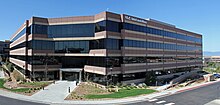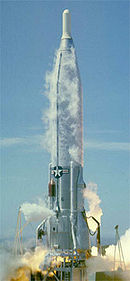United Launch Alliance
| Company type | Private |
|---|---|
| Industry | Aerospace |
| Founded | December 1, 2006 |
| Headquarters | Centennial, Colorado |
Key people |
|
| Products | Atlas V, Delta II, Delta IV |
| Revenue | 1,320,000,000 United States dollar (2018) |
Number of employees | 3,600[1] |
| Website | United Launch Alliance |
United Launch Alliance (ULA) is a joint venture of Lockheed Martin Space Systems and Boeing Defense, Space & Security. ULA was formed in December 2006 by combining the teams at these companies which provide spacecraft launch services to the government of the United States. U.S. government launch customers include both the Department of Defense and NASA, as well as other organizations.
ULA provides launch services using three expendable launch systems – Delta II, Delta IV and Atlas V. The Atlas and Delta launch system families have been used for more than 50 years to carry a variety of payloads including weather, telecommunications and national security satellites, as well as deep space and interplanetary exploration missions in support of scientific research. ULA also provides launch services for non-government satellites: Lockheed Martin retains the rights to market Atlas commercially.[2]
Beginning in October 2014, ULA announced that they intended to undertake a substantial restructuring of the company, its products and processes, in the coming years in order to decrease launch costs. ULA is planning on building a new rocket that will be a successor to the Atlas V, using a new rocket engine on the first stage, with plans to release key design aspects before the end of 2014. In April 2015, they unveiled the new vehicle as the Vulcan, with the first flight of a new first stage no earlier than 2019.
History

Boeing and Lockheed Martin announced their intent to form the United Launch Alliance joint venture on May 2, 2005.[3] ULA merges the production of the government space launch services of the two companies into one central plant in Decatur, Alabama, and merged all engineering into another central plant in Littleton, Colorado. Boeing Integrated Defense Systems Delta IV and Lockheed Martin Space Systems Atlas V are both launchers developed for the Evolved Expendable Launch Vehicle program intended to provide the United States government with competitively priced, assured access to space.
ULA had a peak of six space launch facilities during 2005–2011. It announced a consolidation to five in 2008 with the intent to close one of its two Delta II pads,[4] and closed the pad at Cape Canaveral after its final Delta II launch in 2011.[5]
SpaceX challenged the United States antitrust law legality of the launch services monopoly on October 23, 2005. SpaceX is interested in competing for government launch contracts with the Falcon 9 rocket. On January 7, 2006 the Department of Defense gave preliminary approval to the United Launch Alliance.[citation needed]
In September 2006, the Pentagon renewed their support for ULA, and announced their support to the Federal Trade Commission (FTC).[citation needed] The FTC gave their anti-trust clearance on October 3, 2006.[6] The joint venture began operations on December 1, 2006.[citation needed]
Two years following company formation from units of Lockheed Martin and Boeing, ULA announced it would lay off 350 workers in early 2009, reducing from a company-wide employment of 4200 employees in 2008.[7] In the event, ULA had approximately 3900 employees by August 2009[8]
In late 2009, ULA announced that it intended to build a new headquarters campus for its operations south of Denver, in Centennial, Colorado, in order to move away from facility space it had shared with Lockheed Martin since 2006 when ULA was founded.[8]
In November 2010, United Launch Alliance was selected by NASA for consideration for potential contract awards for heavy lift launch vehicle system concepts, and propulsion technologies.[9]
It was announced in August 2014 that Michael Gass, ULA CEO since ULA was founded in 2006, would step down immediately and that he would be replaced by Tory Bruno, effective immediately.[10]
In September 2014, it was announced that the firm had won a contract from the United States Air Force for US$938 million for additional work on military rocket launch services related to its existing contracts with the US Air Force.[11]
ULA announced in February 2015 that they are considering undertaking domestic production of the Russian RD-180 engine at the Decatur, Alabama rocket stage manufacturing facility. The US-manufactured engines would be used only for government civil (NASA) or commercial launches, and would not be used for US military launches.[12][needs update]
Aerojet Rocketdyne Holdings Inc submitted a $2 billion offer to purchase the joint venture on 8 September 2015.[13] According to industry officials, the bid, if successful, would likely create a unified leadership for the company.[14] On 16 September 2015, spokesperson Todd Blecher for joint owner Boeing commented that Aerojet Rocketdyne's bid was never "seriously entertained" and rejected the offer.[15][16]
Company restructuring after 2014
In October 2014, ULA announced a major restructuring of processes and workforce in order to decrease launch costs by half. One of the reasons given for the restructuring and new cost reduction goals was competition from SpaceX. ULA intends to have preliminary design ideas in place for a blending of the Atlas V and Delta IV technology by the end of 2014, to build a successor that will allow them to cut launch costs in half.[17] The restructuring is intended to facilitate ULA's shift into providing widespread access to space, and growing the customer base to include significant commercial customers in addition to the principally US government customers of ULA's first decade. CEO Tory Bruno stated in November 2014 that he intends to transform the company and reorganize it "to make it more agile, and establish new business models to adapt to the new environment. These changes will lead to improvements in how ULA interacts with its customers, both governmental and commercial, shorter launch cycles, and launch costs cut in half again."[18] ULA intends to shrink the number of company launch pads from six in 2008 and five in 2015 to only two by 2021 as they ramp down the legacy Atlas V and Delta IV launch vehicles.[4]
In May 2015, ULA announced it would decrease its executive ranks by 30 percent in December 2015, with the layoff of 12 executives. The management layoffs are the "beginning of a major reorganization and redesign" as ULA endeavours to "slash costs and hunt out new customers to ensure continued growth despite the rise of SpaceX".[19][20]
In May 2015, ULA stated that it would go out of business unless it won commercial and civil satellite launch orders to offset an expected slump in U.S. military and spy launches.[21]
Launch vehicles
United Launch Alliance is currently flying:
In 2014, ULA began development of a new launch vehicle—Vulcan—to replace both the Atlas and Delta lines of vehicles. Boeing and Lockheed are investing in the new rocket for a duration of only one quarter at a time, so long-term development is not assured by current corporate priorities.[22][23] ULA has further stated in 2015 that they must win both commercial and civil (NASA) space flight contracts, in addition to US government military missions, or they would be forced to go out of business.[24] The ten-year development horizon for the launch vehicle also includes a new second stage—the Advanced Cryogenic Evolved Stage or ACES—that is not planned to be fielded prior to 2023.[25][26]
Facilities
ULA program management, engineering, test and mission support functions are headquartered in Centennial, Colorado. Manufacturing, assembly and integration operations are located in two buildings, one at Decatur, Alabama, and the other in Harlingen, Texas.[7][1]
ULA launches from both coasts of the United States, depending on the customer's desired orbit. East coast Atlas V launches take place from Launch Complex 41 while east coast Delta IV launches take place from Launch Complex 37. Both are located in Cape Canaveral, Florida. West coast launches take place from Vandenberg Air Force Base in southern California.[7]
ULA has announced plans to reduce the number of launch pads in use from five in 2015 to only two by 2021, as part of overall company restructuring and the transition from the legacy Atlas V and Delta IV launch vehicles and to a next-generation launch vehicle (NGLS).[4]
Launches
The first launch conducted by ULA was of a Delta II, from Vandenberg Air Force Base on December 14, 2006.[27] The rocket carried the USA 193 satellite for the National Reconnaissance Office. This satellite failed shortly after launch and was intentionally destroyed on February 21, 2008 by an SM-3 missile fired from the Ticonderoga class cruiser USS Lake Erie.[28]
On June 15, 2007, the engine in the Centaur upper stage of a ULA-launched Atlas V shut down early, leaving its payload – a pair of NRO L-30 ocean surveillance satellites – in a lower than intended orbit.[29] Nonetheless, the mission was declared a success by the customer.[30]
Commercial and international launches aboard Atlas V and Delta rockets are managed by Lockheed Martin Commercial Launch Services and Boeing Launch Services, respectively.
A launch of the Atlas V rocket on 22 March 2016 had a minor first-stage anomaly that led to shutdown of the first-stage engine approximately five seconds before anticipated. The anomaly forced the Centaur upper stage of the rocket to fire for approximately one minute longer than planned, using reserved fuel margin. The preplanned deorbit burn successfully deorbited the stage, but not precisely within the designated location. The anomaly marks the first Atlas V anomaly in over eight years to be publicly acknowledged by ULA.[31]
Controversy
With the introduction of competition from lower-cost launch providers and the increasing costs of ULA launches year-over-year, increased attention has been paid to the amounts ULA has received for US government launch contracts, and for its annual government funding of $1 billion for launch capability and readiness. In particular, an uncontested US Air Force block-buy of 36 rocket cores for up to 28 launches, valued at $11 billion, drew protest from competitor SpaceX. SpaceX has claimed the cost of ULA's launches are approximately $460 million each, and has proposed a price of $90 million to provide similar launches.[32] In response, former ULA CEO Michael Gass claimed an average launch price of $225 million, with future launches as low as $100 million.[33] ULA released contract values to the public and CEO Tory Bruno testified before Congress in March 2015, to "correct these misconceptions".[citation needed] The $11B frequently referred to by SpaceX as covering the cost of 36 cores (28 missions) is incomplete and includes launch costs for another 50 missions. The actual contract structure is for a manufacturing contract of $6.4B to build 50 rockets, a second manufacturing contract to build another 28 rockets, and a third launch contract of $6.9B to fly all 78. The actual average cost of flying ULA's fleet of 15 different rocket types across this window is $225M ($17.6B/78), with the least expensive at $164M, an Atlas V 401 rocket roughly equivalent to a Falcon 9 v1.1, and the most expensive at $400M for the Delta IV Heavy.[citation needed]
A political controversy arose in March 2016 following the public remarks on March 15 by ULA VP of Engineering Brett Tobey that included comments that were "resentful of SpaceX" and dismissive of one of the two competitors (Aerojet Rocketdyne) for the new engine that will power the Vulcan launch vehicle currently under development.[34] Tobey resigned on 16 March,[35] while ULA CEO Tory Bruno disavowed the remarks.[36] Senator John McCain has asked the Defense Department to investigate the comments that implied the DoD may have shown "favoritism to a major defense contractor or that efforts have been made to silence members of Congress."[37] and the Secretary of Defense has asked the Inspector General to look into the situation.[38]
See also
References
- ^ a b "Quick Facts". Retrieved 21 November 2014.
- ^ Justin Ray (November 23, 2009). "Atlas 5 launches Intelsat communications satellite". Spaceflight Now.
- ^ "About ULA". ULA.
- ^ a b c
Butler, Amy (17 February 2015). "Aerospace Daily & Defense Report New Rocket, White Tails In ULA's Long-Term Strategy". Aviation Week. Retrieved 22 February 2015.
[the] plan to field a new rocket engine with Blue Origin called the BE-4 is only step one of a larger strategic plan to take the company from a sole-source benefactor mentality to competing in a burgeoning commercial market. ... The Atlas V and Delta IV ... both have a limited future.
- ^ Graham, William (2 July 2014). "ULA Delta II successfully lofts OCO-2 to orbit". NASASpaceflight.com. Retrieved 22 February 2015.
- ^ (press release) (October 3, 2006). "FTC gives clearance to United Launch Alliance". Spaceflight Now.
- ^ a b c "United Launch Alliance plans layoffs". Denver Business Journal. 2008-11-14. Retrieved 2014-11-16.
- ^ a b Avery, Greg (2009-08-05). "ULA seeks land for a combined HQ". Denver Business Journal. Retrieved 2014-11-16.
- ^ "NASA Selects Companies for Heavy-Lift Vehicle Studies". NASA. Retrieved 8 November 2010.
- ^ "United Launch Alliance Taps a Lockheed Executive To Replace CEO Gass". Space News. 2014-08-12. Retrieved 2014-08-13.
- ^ Boeing-Lockheed venture wins $938 million in U.S. rocket launch deal. Reuters, 17 September 2014
- ^ Fleischauer, Eric (7 February 2015). "ULA's CEO talks challenges, engine plant plans for Decatur". Decatur Daily. Retrieved 9 February 2015.
- ^ Shalal, Andrea (8 September 2015). "Aerojet makes $2 billion offer for Lockheed-Boeing joint venture: sources". Reuters. Retrieved 9 September 2015.
- ^ Pasztor, Andy (8 September 2015). "Aerojet Bids About $2 Billion for Boeing-Lockheed Rocket Venture". Wall Street Journal. Retrieved 9 September 2015.
- ^ Shalal, Andrea. "UPDATE 2-Boeing rejects Aerojet Rocketdyne bid for ULA launch venture". Reuters. Retrieved 16 September 2015.
- ^ Boeing rejects Aerojet Rocketdyne bid for ULA launch venture, accessed 2015-09-16.
- ^ Avery, Greg (2014-10-16). "ULA plans new rocket, restructuring to cut launch costs in half". Denver Business Journal. Retrieved 2014-11-14.
- ^ Delgado, Laura M. (2014-11-14). "ULA's Tory Bruno Vows To Transform Company". SpacePolicyOnline.com. Retrieved 2014-11-14.
- ^ Shalal, Andrea (2015-05-15). "Lockheed-Boeing venture lays off 12 executives in major reorganization". Reuters. Retrieved 16 May 2015.
- ^
Shalal, Andrea (2015-05-21). "Lockheed-Boeing rocket venture needs commercial orders to survive". Reuters. Archived from the original on 2015-05-22. Retrieved 2015-05-22.
{{cite news}}: Unknown parameter|deadurl=ignored (|url-status=suggested) (help) - ^ "Lockheed-Boeing rocket venture needs commercial orders to survive". Yahoo News. 21 May 2015.
- ^ Avery, Greg (2015-04-16). "The fate of United Launch Alliance and its Vulcan rocket may lie with Congress". Denver Business Journal. Retrieved 6 March 2016.
- ^ "AIRSHOW-Lockheed says rocket launch venture urgently needs U.S. law waiver". 2015-06-14. Retrieved 2016-03-06.
- ^ "Lockheed-Boeing rocket venture needs commercial orders to survive". Yahoo News. 21 May 2015.
- ^ Gruss, Mike (13 April 2015). "ULA's Vulcan Rocket To be Rolled out in Stages". Space News. Retrieved 6 March 2016.
- ^
Butler, Amy (11 May 2015). "Industry Team Hopes To Resurrect Atlas V Post RD-180". Aviation Week & Space Technology. Archived from the original on 12 May 2015. Retrieved 6 March 2016.
{{cite news}}: Unknown parameter|deadurl=ignored (|url-status=suggested) (help) - ^ "United Launch Alliance set for takeoff". Metro Denver EDC.
- ^ "DoD Succeeds In Intercepting Non-Functioning Satellite" (Press release). U.S. Department of Defense. February 20, 2008. Retrieved 2009-10-09.
- ^ "NRO Shortfall May Delay Upcoming ULA Missions". Aviation Week.
- ^ "NRO L-30 Launch Update" (PDF). National Reconnaissance Office.
- ^ Ray, Justin (24 March 2016). "Atlas 5 rocket forced to improvise during Tuesday's climb to orbit". SpaceFlight Now. Retrieved 24 March 2016.
- ^ "SpaceX launches protest of Air Force rocket contract". Defense Systems.
- ^ "Responding to Critics, ULA Discloses Pricing Information". Space News.
- ^
de Selding, Peter B. (2016-03-16). "ULA intends to lower its costs, and raise its cool, to compete with SpaceX". SpaceNews. Retrieved 2016-03-19.
A de facto monopoly was born with U.S. government blessing and with a series of lucrative U.S. government contracts whose principal goal was reliability and capability, not value for money.
- ^ deSelding, Peter B. (2016-03-17). "ULA VP resigns following remarks on company's competitive position, strategy". SpaceNews. Retrieved 2016-03-19.
- ^ Berger, Brian (2016-03-16). "ULA chief disavows his head engineer's take on Vulcan engine competition". SpaceNews. Retrieved 2016-03-19.
- ^ Berger, Brian (2016-03-18). "McCain calls for investigation of fired ULA executive's controversial comments". SpaceNews. Retrieved 2016-03-19.
- ^ Gould, Joe; Seligman, Laura (2016-03-18). "Carter Asks IG To Look Into 'Disturbing' ULA Exec Comments on McCain". Defense News. Retrieved 2016-03-19.
External links
- United Launch Alliance site
- Distributed Launch - Enabling Beyond LEO Missions, a ULA take on propellant depots and propellant-cargo launches, September 2015.
- Launch Vehicle Recovery and Reuse, AIAA paper, 2015.
- Free CubeSat rideshares offered by ULA for Atlas V launches, November 2015.
- Boeing, Lockheed Martin to Form Launch Services Joint Venture
- FTC gives prelimanary clearance to United Launch Alliance
- United Launch Alliance begins Operations
- U.S. Rocket Supplier Looks to Break ‘Short Leash’, Wall Street Journal, 19 July 2015.








